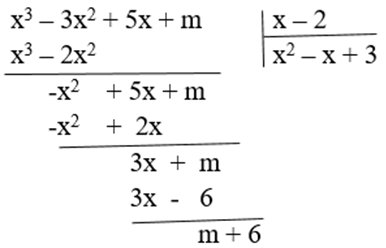Hãy nhập câu hỏi của bạn vào đây, nếu là tài khoản VIP, bạn sẽ được ưu tiên trả lời.

Sử dụng định lý Bezout:
a/ \(g\left(x\right)=0\Rightarrow\left\{{}\begin{matrix}x=1\\x=2\end{matrix}\right.\)
\(f\left(x\right)⋮g\left(x\right)\Rightarrow\left\{{}\begin{matrix}f\left(1\right)=0\\f\left(2\right)=0\end{matrix}\right.\) \(\Rightarrow\left\{{}\begin{matrix}a+b=1\\2a+b=4\end{matrix}\right.\) \(\Rightarrow\left\{{}\begin{matrix}a=3\\b=-2\end{matrix}\right.\)
b/ \(g\left(x\right)=0\Rightarrow x=-1\)
\(\Rightarrow f\left(-1\right)=0\Rightarrow-a+b=2\Rightarrow b=a+2\)
Tất cả các đa thức có dạng \(f\left(x\right)=2x^3+ax+a+2\) đều chia hết \(g\left(x\right)=x+1\) với mọi a
c/ \(g\left(x\right)=0\Rightarrow x=-2\Rightarrow f\left(-2\right)=0\Rightarrow4a+b=-30\)
\(2x^4+ax^2+x+b=\left(x^2-1\right).Q\left(x\right)+x\)
Thay \(x=1\Rightarrow a+b=-2\)
\(\Rightarrow\left\{{}\begin{matrix}4a+b=-30\\a+b=-2\end{matrix}\right.\) \(\Rightarrow\left\{{}\begin{matrix}a=-\frac{28}{3}\\b=\frac{22}{3}\end{matrix}\right.\)
d/ Tương tự: \(\left\{{}\begin{matrix}f\left(2\right)=8a+4b-40=0\\f\left(-5\right)=-125a+25b-75=0\end{matrix}\right.\) \(\Rightarrow\left\{{}\begin{matrix}a=\\b=\end{matrix}\right.\)

a) Ta có: \(g\left(x\right)=x^2-3x+2\)
\(=x^2-x-2x+2\)
\(=x\left(x-1\right)-2\left(x-1\right)\)
\(=\left(x-1\right)\left(x-2\right)\)
Vì \(f\left(x\right)⋮g\left(x\right)\)
\(\Rightarrow f\left(x\right)=\left(x-1\right)\left(x-2\right)q\left(x\right)\)
\(\Rightarrow\hept{\begin{cases}f\left(1\right)=\left(1-1\right)\left(1-2\right)q\left(1\right)=0\left(1\right)\\f\left(2\right)=\left(1-2\right)\left(2-2\right)q\left(2\right)=0\left(2\right)\end{cases}}\)
Từ \(\left(1\right)\Leftrightarrow1^4-3.1^3+1^2+a+b=0\)
\(\Leftrightarrow-1+a+b=0\)
\(\Leftrightarrow a+b=1\left(3\right)\)
Từ \(\left(2\right)\Leftrightarrow2^4-3.2^3+2^2+2a+b=0\)
\(\Leftrightarrow-4+2a+b=0\)
\(\Leftrightarrow2a+b=4\left(4\right)\)
Từ \(\left(3\right);\left(4\right)\Rightarrow\hept{\begin{cases}a+b=1\\2a+b=4\end{cases}\Leftrightarrow\hept{\begin{cases}a=3\\b=-2\end{cases}}}\)
Vậy a=3 và b=-2 để \(f\left(x\right)⋮g\left(x\right)\)
Các phần sau tương tự

\(x^8+x^4+1\)
\(=\left(x^8+2x^4+1\right)-x^4\)
\(=\left(x^4+1\right)^2-x^4\)
\(=\left(x^4+1-x^2\right)\left(x^4+1+x^2\right)\)
\(=\left(x^4-x^2+1\right)\left(x^4+2x^2-x^2+1\right)\)
\(=\left(x^4-x^2+1\right)[\left(x^2+1\right)^2-x^2]\)
\(=\left(x^4-x^2+1\right)\left(x^2+1-x\right)\left(x^2+1+x\right)\)

A(x) chia hết cho B(x) khi m + 6 = 0 ⇒ m= -6
b) (x – 4)(x2 + 4x + 16) – x( x2 – 6) = x3 – 64 – x3 + 6x = 6x – 64
Vậy 6x – 64 = 2
6x = 66
x = 11

â) viết lại biểu thức bên trái = (x2+5x-3)(x2-2x-4)+(14+a)x+b-12
Để là phép chia hết thì số dư =0
Số dư chính là (14+a)x+b-12=0 => a+14=0 và b-12=0 <=>a=-14 và b=12
b) làm tương tự phân tích vế trái thành (x3-2x2+4)(x2+9x+18)+(a+32)x2+(b-36)x
số dư là (a+32)x2+(b-36)x=0 =>a=-32 và b=36
c) Tương tự (x2-1)4x+(a+4)x+b
số dư là (a+4)x+b =2x-3 =>a+4=2 và b=-3 <=>a=-2 và b=-3

\(1.x^2-4x+4=8\left(x-2\right)^5\)
\(\Leftrightarrow\left(x-2\right)^2-8\left(x-2\right)^5=0\)
\(\Leftrightarrow\left(x-2\right)^2\left[1-8\left(x-2\right)^3\right]=0\)
\(\Leftrightarrow\orbr{\begin{cases}\left(x-2\right)^2=0\\1-8\left(x-2\right)^3=0\end{cases}}\)
\(\Leftrightarrow\orbr{\begin{cases}x=2\\\left(x-2\right)^3=\frac{1}{8}\end{cases}\Rightarrow\orbr{\begin{cases}x=2\\x=\frac{5}{2}\end{cases}}}\)
\(T=4\left(a^3+b^3\right)-6\left(a^2+b^2\right)\)
\(=4\left(a+b\right)\left(a^2-ab+b^2\right)-6a^2-6b^2\)
\(=4\left(a^2-ab+b^2\right)-6a^2-6b^2\)(Vì a+b=1)
\(=4a^2-4ab+3b^2-6a^2-6b^2\)
\(=-2a^2-4ab-2b^2\)
\(=-2\left(a+b\right)^2=-2\)

Bài 1 :
b, Ta có : \(4x^2-25-\left(2x-5\right)\left(2x+7\right)\)
\(=\left(2x-5\right)\left(2x+5\right)-\left(2x-5\right)\left(2x+7\right)\)
\(=\left(2x-5\right)\left(2x+5-2x-7\right)\)
\(=-2\left(2x-5\right)\)
c, Ta có : \(x^3+27+\left(x+3\right)\left(x-9\right)\)
\(=\left(x+3\right)\left(x^2-3x+9\right)+\left(x+3\right)\left(x-9\right)\)
\(=\left(x+3\right)\left(x^2-3x+9+x-9\right)\)
\(=x\left(x+3\right)\left(x-2\right)\)
Bài 2 :
a, Để \(x^3+3x^2+3x-2⋮x+1\)
<=> \(x^3+1+3x^2+3x-3⋮x+1\)
<=> \(\left(x+1\right)^3-3⋮x+1\)
Ta thấy : \(\left(x+1\right)^3⋮x+1\)
<=> \(-3⋮x+1\)
<=> \(x+1\inƯ_{\left(3\right)}\)
<=> \(x+1=\left\{1,-1,3,-3\right\}\)
<=> \(x=\left\{0,-2,2,-4\right\}\)
Vậy ...
b, Để \(2x^2+x-7⋮x-2\)
<=> \(2x^2-8x+8+9x-15⋮x-2\)
<=> \(2\left(x-2\right)^2+9x-15⋮x-2\)
Ta thấy : \(2\left(x-2\right)^2⋮x-2\)
<=> \(9x-15⋮x-2\)
<=> \(9x-18+3⋮x-2\)
Ta thấy : \(8\left(x-2\right)⋮x-2\)
<=> \(3⋮x-2\)
<=> \(x-2\inƯ_{\left(3\right)}\)
<=> \(x-2=\left\{1,-1,3,-3\right\}\)
<=> \(x=\left\{3,1,5,-1\right\}\)
Vậy ...


Đáp án: C